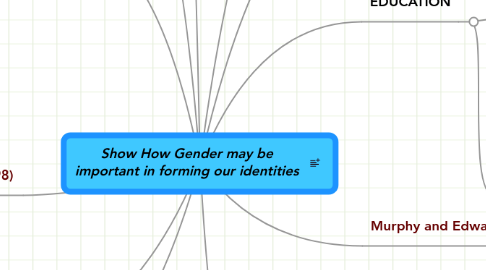
1. Masculine+Feminine at same time = androgynous. Neither Masculine or Feminine = undifferentiated
2. Sex and Gender are not the same
2.1. Sex - A person’s sex is determined by chromosomes and body chemistry.
2.1.1. XX=Female XY = Male, XXY=undetermined
2.1.1.1. Physical sex can be changed. Legal sex cannot.
2.2. A persons gender is more closely associated with how they feel about themselves and how they behave in the eyes of others
2.3. Chapter 2, pg 49
3. Sandra Bem
3.1. (1989) Children look at social and cultural characteristics when constructing gender categories. Less influence by biology because they do not have the knowledge.
4. Francis (1997,98)
4.1. Observed primary aged children partaking in role play
4.1.1. Noted: Boys taking high staus positions, exerting domination and power more often than girls
4.1.2. Noted: Girls took sensible, selfless, mature behaviours
4.1.3. Girls took on typically feminine roles, boys took masculine.
4.1.4. No single Masculinity or Femininity.Diversity of Masculinities and Femininities ( Ger)
4.2. Not all children took on stereotypical roles, some challenged or ignored them.Roles were Fluid.
4.3. Chapter 2, pg 59 - 60
5. Gender Development Durkin(1995)(GER)
5.1. Childrens Preference for toys from age 3-4 years
5.2. Gender Appropriate
5.3. Early Evidence of Gender Identity
5.4. Chapter 2 page 56
6. Kolhberg,(1966)(GER)
6.1. Children under 5 Particular and distinctive characteristics
6.2. Fooled by context man in a dress
7. Gender chosen by self categorization
8. Turner et al
8.1. Individuals look at social categories and decide if they are in that category
8.2. Choice is through similarities rather than differences
8.2.1. The more different the image, the less likely an individual will identify with it.
8.3. Chapter 2, Pgs 47-48
9. Freud
9.1. Believed female gender was signified by LACK of a penis
9.2. A childs psycho sexual development depends on identifying with other of same sex.
9.3. Chapter 2, pg 49
10. EDUCATION
10.1. Until 60s/70s education was biased towards boys. The 90's showed girls outperforming boys
10.1.1. Charts show overall %'s increasing for boys and girls
10.1.2. Girls consistently outperform boys
10.1.3. Girls beginning to achieve higer results than boys in maths
10.1.4. Girls outperform boys in science
10.1.5. Cognitive testing shows women do better in verbal tests, while men do better in spatial tests.
10.1.5.1. Differences found to be innate (Kimura 92). However, lifestyle factors cannot be excluded.
10.1.5.2. Linda Birke - Test show limited range of skills. Interpretation of tests problematic. Many results show little or no difference. Instead show similarities which go unreported. (Chapter 2, pg 64)
10.1.5.2.1. Birke questions reliance on the idea of fixed differences. Is concerned about the relationships drawn between cognitive test and biological predispositions.
10.1.5.2.2. Differences may be due to an interaction between biology and social cultural experiences.
10.1.5.3. Influence of Social +Cultural Factors (Ger)
10.2. Chapter 2, Pgs 61 - 74
11. Murphy and Edwards
11.1. Claim 1
11.1.1. Boys and girls foster different interests, attitudes and behaviours prior to school, which are perpetuated at school
11.2. Claim2
11.2.1. Feminine and masculine identities are perceived in a way by teachers that can have consequences on achievements
11.3. Claim 3
11.3.1. Boys and girls drawn on different interests and experiences in their school work.
